Don't wanna be here? Send us removal request.
Text
For the soundtrack, I looked into traditional Japanese music or music that geisha's dance to but what I found is that either it doesn't really go with the title sequence because of the rhythm or it has words in Japanese which I think is distracting and can be confusing if you don't understand Japanese so I decided not to use that and researched into what kind of soundtracks were used for the movie. I discovered that the main soundtrack was created specifically for the movie, I’ve tried it and found that it goes really well with my title sequence so I decided to use that.
youtube
youtube
youtube
0 notes
Text
For the typography, at first I thought something simple and blocky easy to read, but then when I tried it out to me it feels like it really clashes with the look of in ink drops and elegance of the geisha. So, I thought maybe something more handwritten and in my opinion that looks a lot better. I looked through some typefaces and what I tried to find was some sort of type that would be similar to calligraphy look. When I found a type that I like I took it into illustrator and deleted small bits of the letters so that it looks like it's old and it's scratched off the paper. You can see like little gaps where the paper is visible I think that goes really well with the old book idea.

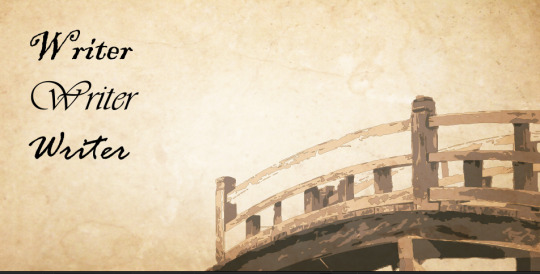
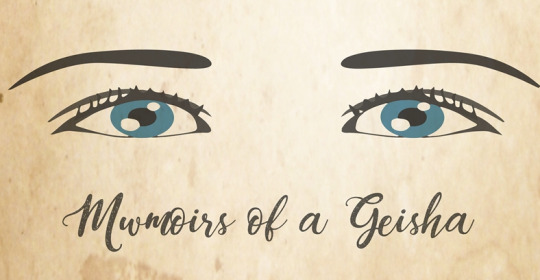
0 notes
Text

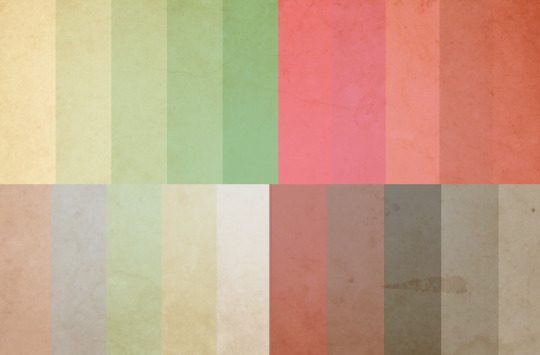
After deciding on my drawings that I want to show in the title sequence I started thinking about colour palettes. Each of my drawings has a slightly different colour palette. I tried to stick to the idea of red black white and blue which are the main colours in Japan however I did end up add in other colours like the coin and tea, details in the kimono. So I did some mockups of how the colours would look on the book paper when the opacity is down to create that what washed out look. Some of the colours I adjusted later depending on what looked better in the title sequence as a whole but I kept the same idea of the main colours.
0 notes
Text
Storyboards #2
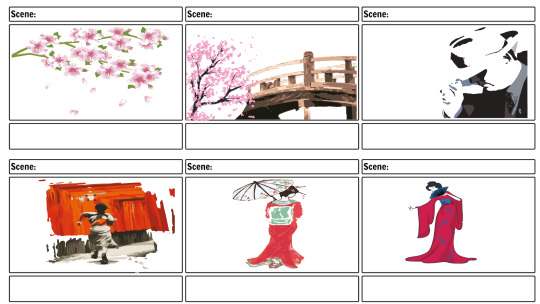

I've changed my storyboards because even though I like the first version I thought I need to include more of a geisha and more obvious representations for people that may not have knowledge about Japanese culture prior watching the movie. So I've included an image of a geisha and redrawn one of the scenes in the movie where she's running but then I thought maybe it's revealing too much of the movie. So I have added a man representing one of the main characters in the movie that was also one of the main influences to the main characters geisha life and excluded the running scene in the final version. I didn't do a third version of storyboards because I've decided that I am going to combine elements from 2 first storyboards that I like and then think about what I'd like to change in the spaces that I left blank. Also, I have taken out the image of a geisha with a fan because even though I think it's a nice image didn't really turn out to be the same style as all my other drawings so I excluded it because I felt like it didn't fit the rest of the title sequence.

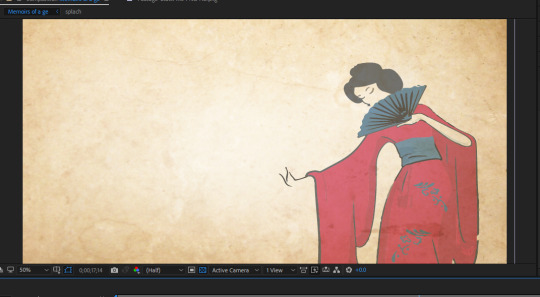

Some of the images like the tea cup above I've changed to a different style because I wanted to keep the flow and each image somehow related to one another. I was looking for ways to animate it so, for example, a coin falling into the tea and splashing, so I didn't use that one I used different one just so that I could animate that flashing effect. For the ink dropping, I was thinking about black stains as above but when I tried it I thought it would be nice if the ink revealed the image rather than going on top of it.
0 notes
Text
I was thinking about a way to present this title sequence and I thought to me Japan and all of the geisha culture really associates with ink paper textures and all that kind of things so I decided to use an old paper look at first but then when I tried it looks a bit flat like there's no flow or so the sort of a story going on so I decided to create it has a book. For the cover I decided to use the main colours that geisha uses for makeup - black, red and white I decided to choose a flower pattern because flowers are a very common look on kimonos. I chose to fade out colours and I'm going going to keep this look in title sequence as I am aiming for an old book with paper texture look, fade out colours would blend in nicer and give the impression of old pages.


0 notes
Text
Calligraphy, art, and style for my title sequence
I’ve decided to choose ink and watercolour bleeds as a base style for my title sequence. Ink is an essential element of calligraphy which is a big part of Japanese culture. It’s also considered to be an art form as well as water colouring that I’m going to use to add colour and mood. It’s usually done on a paper that has a visible texture which ties in well with the time that ‘Memoirs of a Geisha’ is happening in because a lot of people associate paper that has a strong texture with the past and history.
Calligraphy and beautiful handwriting is considered a reflection of someone’s character and personality in Japan. It can be argued that ink bleeds are a reflection of ‘Memoirs of a Geisha’ main character fight destiny and obedience vs self-determination. Watercolour bleeds relate to one of the main elements in the novel - water and it’s ability to adapt at the same time being a force that spreads.
Because of the paper texture, I think it would be nice to create an appearance as if the title sequence is a short story appearing on a page, therefore, I’m thinking to use drawing style that has more hand drawn feeling than digital but still clean and tidy.


References:
Study.com. (n.d.). Japanese Calligraphy: Art, Symbols & History | Study.com. [online] Available at: https://study.com/academy/lesson/japanese-calligraphy-art-symbols-history.html [Accessed 2019].
Hays, J. (n.d.). JAPANESE CALLIGRAPHY | Facts and Details. [online] Factsanddetails.com. Available at: http://factsanddetails.com/japan/cat20/sub129/item2886.html [Accessed 2019].
Nishizawa, A. (n.d.). Learning about the Japanese Culture through Calligraphy. [online] Japanese Language School - Coto Japanese Academy. Available at: https://cotoacademy.com/japanese-calligraphy/ [Accessed 2019].
0 notes
Text
Colours and patterns

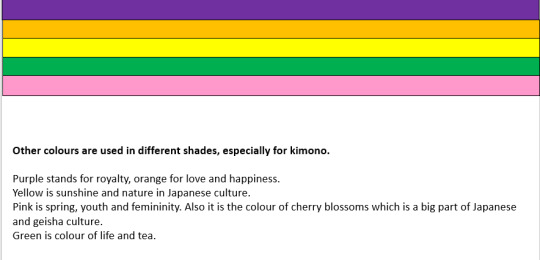
Japanese culture is closely linked to seasons, therefore, each month has nature references. Geisha had the ability to set the fashion standard and it usually followed these nature references. Below is a list of colour combinations worn by geisha according to month:
January - sprout green and deep purple
February - crimson and purple
March - peach and khaki
April - white and burgundy
May - orange, yellow and purple
June - green and yellow
July - red and yellow
August - cedar bark and sky blue
September - lavender and burgundy
October - rose and blue
November - vermilion and grey-green
December - lavender and deep blue
Patterns are a big part of kimono. It also has meanings But main themes are different seasons which then include a variety of kimono patterns
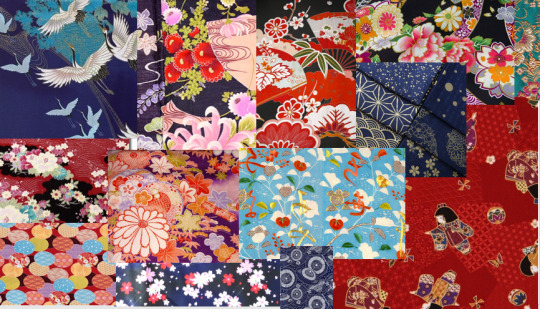
References:
Japan Info. (n.d.). Black, White and Red: The 3 Colors of Beauty in Japan – Japan Info. [online] Available at: https://jpninfo.com/36914 [Accessed 2019].
Japanese Patterns of Design. (n.d.). Geisha: Makeup, Hairstyles, and History of Highly Skilled Artists. [online] Available at: https://www.patternz.jp/geisha-makeup-hairstyles-history/ [Accessed 2019].
Japanese Traditional and Ceremonial Colors. (n.d.). [ebook] G.Thompson. Available at: http://www.yamakawadojo.com/Japanese%20Traditional%20Colors.pdf [Accessed 2019].
Japanese Kimono Online Shop From Kyoto Japan. (n.d.). Japanese traditional Kimono, the pattern and the color. [online] Available at: http://japanese-kimono.net/kimono-pattern-color/ [Accessed 2019].
Olesen, J. (n.d.). Color Meanings In Japan. [online] Color-Meanings.com. Available at: https://www.color-meanings.com/color-meanings-japan/ [Accessed 2019].
W, S. (n.d.). The Traditional Colors of Japan. [online] Tofugu. Available at: https://www.tofugu.com/japan/color-in-japan/ [Accessed 2019].
Classroom.synonym.com. (n.d.). What Is the Meaning of Color in Japanese Culture? | Synonym. [online] Available at: https://classroom.synonym.com/what-is-the-meaning-of-color-in-japanese-culture-12081009.html [Accessed 2019].
0 notes
Text
Storyboard #1
Based on the symbolism and visual elements visual elements I’ve done storyboards


I do have other ideas and will be developing these further. I don’t think live action footage would be a good idea for this because in geisha culture is bright colours, the texture is important. Therefore I'm thinking about animation or photography, in which case the idea of the cup would need to be changed as I don’t have enough skills to animate in 3D and without that transition from the side to the top of the cup is very difficult.
0 notes
Text
Why the movie and the book?
I’ve decided to use not only the movie but the book too to create my title sequence. The movie may suggest the style and the mood I can follow, but the book offers symbolistic meanings and goes into more detail which I think is helpful for generating ideas and deciding what elements to show in the sequence and what message it will send to the viewer.
Short analysis
I have extracted 4 main themes in the book and the movie
Destiny vs. Self-Determination
Throughout the novel, she describes herself as a river, a metaphor that captures the duelling forces of destiny and self-determination in her life.
Growing Up
Both movie and book are focused on a journey, growing up faced with challenges, full of different experiences. The movie as a visual form of communication is based on ageing - from a child to an adult. Meanwhile, the book is more focused on the psychological side.
Love
In the novel love is only an illusion to hide reasons and nature of the relationships between geisha and danna (a wealthy man who covers all costs related to becoming and being a geisha) most geishas believe that love is not possible for them. The main character, however, is an exception. After the Chairman showed her kindness when she was a teenager, she promised her self to work her entire life to be a good enough geisha so that he would want to be her danna.
Tradition, Ritual and Gender
The main character enters the geisha world unfamiliar with how an apprentice geisha must act or speak to those around her. By focusing on a character who is completely ignorant of geisha practices, the traditions are shown in a very detailed but understandable way. However, these traditions are displayed more like tools to gain financial security rather than important values.
Symbolism/key visual elements/items
Water
Like water shifting to fit any shape. The main character is seen like water, signifying its ability to adapt. Also, the main character must choose between the two conflicting symbolic meanings of water: the water that lets external forces guide it, or the water that determines its own direction. In the movie rain is also an important element, it can be argued that it represents chaos fear and uncertainty
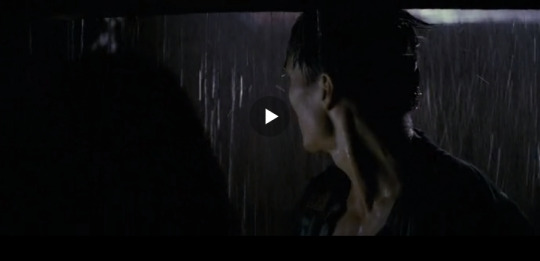
.Blue eyes
Translucent blue eyes lead many characters to believe that she has a lot of water in her personality, therefore, she adapts quickly, yet can be strong. Her eyes also represent her honest and truthful nature, which contrasts with the artificial world of the geisha. Her eyes are also, her ticket to success as in Japan blue eyes are considered exotic therefore men are more attracted by it.

Cherry blossoms
Japanese cherry blossoms are a metaphor for human existence. Blooming season is powerful, beautiful and blinding, but short, as human life is. It can be argued that in Memoirs of a geisha this idea is used to highlight the youth of geishas, the peak of their career. It’s also a sign of rebirth - just like the main character found a purpose in life, she met the chairman and dedicated her life to be worthy of him when at the cherry blossom festival.
Tea
Serving tea is a big part of becoming a geisha
‘One of the most important ideas behind the Japanese tea ceremony is the concept of “Wabi” and “Sabi”. “Wabi” represents the spiritual experiences of human lives and it symbolises quiet and sober refinement. “Sabi” represents the material side of life and it means weathered or decayed. Understanding this emptiness and imperfection is considered an important part of spiritual awakening.’
Therefore I think in the novel, this highlights the reality of living as a Geisha - even though Japanese culture and traditions (which is what geisha meant to be following) encourage spiritualism, geisha main focus is shifted to material things.
Fans and umbrellas
The fan is a symbol of welfare and prosperity as it spreads out when we open it, similar to a blooming flower. As the fan starts from a single point and the strips go to various directions, they are considered to resemble the various paths in life after the single point of birth. As one of the geisha duties is to entertain and vital skill is dancing fans are combined in that and an outfit is considered incomplete without one. Umbrellas are used for dancing and stylistic reasons
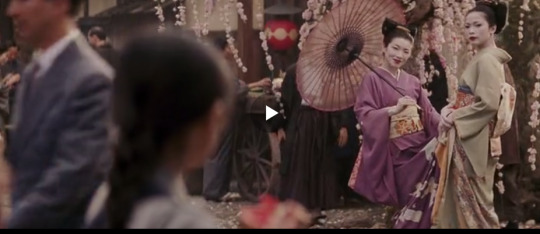
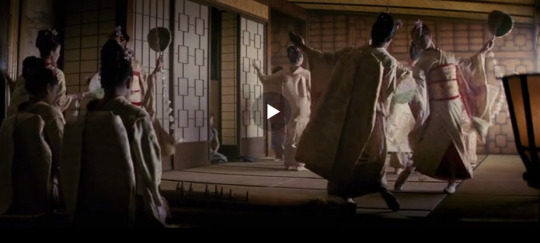
Handkerchief
Most geisha create the illusion of love so that they could make their living by flirting and fawning over men without ever experiencing love for them. Even though most geisha are cynical when it comes to finding love, the main character keeps the Chairman’s handkerchief in the sleeve of her kimono every day as a reminder of his kindness and the possibility of love.

References:
Japan Info. (2015). Japanese Culture and the Use of Fans – Japan Info. [online] Available at: https://jpninfo.com/17478 [Accessed Feb. 2019].
Newworldencyclopedia.org. (n.d.). Geisha - New World Encyclopedia. [online] Available at: http://www.newworldencyclopedia.org/entry/Geisha [Accessed 2019].
Not Without My Passport. (n.d.). The Meaning of Cherry Blossoms in Japan: Life, Death and Renewal. [online] Available at: https://notwithoutmypassport.com/cherry-blossom-meaning-in-japan/ [Accessed 2019].
Ledford, A. (n.d.). Umbrellas in Japan. [online] Tofugu. Available at: https://www.tofugu.com/japan/umbrellas-in-japan/ [Accessed 2019].
Truly Experiences. (n.d.). The History of Japanese Tea. [online] Available at: https://trulyexperiences.com/blog/history-of-japanese-tea/ [Accessed 2019].
Golden, Arthur. Memoirs of a Geisha: A Novel. New York, NY: Alfred A. Knopf, 1997.
https://www.youtube.com/watch?v=jIClcAjUMLs
0 notes
Text
Briefly about Geisha
Brief history
Geisha is a Japanese cultural figure mainly focused to entertain men. Geisha tradition started envolving in the mid-eighteen century and reached its peak in about 1920′s. First geishas were actually men entertaining the guests with drums and music in so-called pleasure houses, however, at that time most guests were men and male geishas were eventually replaced by women dancers.
Geishas were expected to remain single and ‘unfamiliar with a man’s touch’. If geisha were to decide otherwise, she must retire from the profession.
How to become a geisha?
To become a geisha in early times girls were sold by their parents, latter mothers trained their daughters. Training starts from a young age, last several years and consists of three stages. Fist stage is working as a maid, doing everything without question. Work was often difficult at this stage is basically designed to break the girl's spirit. During this stage, girls would also go to a school where they learn to dance, dress etc as a geisha. The second stage is housekeeping chores. The third stage is observing and practising skills like learning to make’proper’ tea and attending parties as an apprentice of their teacher and observing their skills, for example, ‘the art of conversation’ with men.
‘ Modern geisha still live in traditional geisha houses called okiya in the hanamachi areas, particularly during their apprenticeship. Many experienced geisha who are successful enough choose to live independently during the later part of their careers. The elegant, high-culture world that geisha are a part of is called karyūkai ("the flower and willow world").’
young women who wish to become geisha nowadays begin their training after completing middle school or even high school or college, with many women beginning their careers in adulthood. Geisha still study traditional instruments as well as traditional songs, Japanese traditional dance, tea ceremony, literature, and poetry. By watching other geisha, and with the assistance of the owner of the geisha house, apprentices also become skilled in the complex traditions surrounding selecting and wearing kimono, and in dealing with clients.
Geisha appearance
The traditional makeup of an apprentice geisha features a thick white base with red lipstick and red and black accents around the eyes and eyebrows that are drawn on. Geisha always wear kimono. Apprentice geisha wear colourful kimono. Older geisha wear more subdued patterns and styles. The sign of a wealthy is having geisha not wearing a kimono more than once. The colour pattern and style of kimono is also dependent on the season and the event the geisha is attending.
Bibliography:
BBC. Geisha Girl. January 2006. Dalby, Liza Crihfield. Geisha. Berkeley, CA: University of California Press, 1983. Foreman, Kelly M. The Gei of Geisha Music, Identity and Meaning. England: Ashgate Pub. Company, 2007. Gallagher, John. Geisha A Unique World of Tradition, Elegance, and Art. London: Produced by PRC Pub, 2003. Graham-Diaz, Naomi. "Make-Up of Geisha and Maiko." Immortal Geisha. Retrieved December 3, 2007. Henshall, K.G. A History of Japan. London: Macmillan Press, 2001.
1 note
·
View note
Text
#Divergent
In a futuristic Chicago, society is divided into 5 factions. Abnegation the selfless, Dauntless the brave, Erudite the intelligent, Candor the honest, and Amity the peaceful. When all teenagers reach the age of 16, they must choose to either stay in their faction of birth, or transfer into another faction. Beatrice Prior must make the decision to stay with her family in a faction she feels she isn't right for, or to transfer into another faction, and leave her family behind. What follows is a highly competitive initiation, where the newly renamed Tris must make some tough decisions, but she must also keep a secret that she was warned could mean death, while she juggles friends, initiation, and a newfound love interest. But there is a secret lying beneath everything that threatens to tear the city apart.
This movie doesn't have its own title sequence. Each faction has its own symbol an image that represents it so one of the ideas for this title sequence would be to use those images as the basis and then use characteristics of each faction to tie it all together. The most difficult part of creating this title sequence I think would be illustrating it because as filming it live action I think would be quite difficult because it's fictional and each faction has its own representative clothing and things like that so would be really hard to recreate those looks. So it could be illustrated and one of my ideas of how to tie it all together could be futuristic computer-generated look with very blocky numbers and typefaces flickering lights like a broken computer screen and so on.
youtube
0 notes
Text
#3 steps above heaven
Good girl from a wealthy background meets bad boy from the streets. Bike-racing thug with an uncontrollable temper falls for well-brought up schoolgirl headed for higher things. She despises him but his strength and charm inevitably win her over. But can he rise above his baser instincts and will she give up everything for love? Plenty of action and unexpected romantic moments. Romeo and Juliet in a high speed setting.
Title sequence could be zooming in to Polaroid style photographs and type underneath. When zoomed into the photograph it depends on what I'm showing but main elements could be speeding road that follows into other elements like tattoos gifts fighting close up centre smiles eyes sprays of perfume school etc.
youtube
0 notes
Text
#Memoirs of a Geisha
In 1929 an impoverished nine-year-old named Chiyo from a fishing village is sold to a geisha house in Kyoto's Gion district and subjected to cruel treatment from the owners and the head geisha Hatsumomo. Her stunning beauty attracts the vindictive jealousy of Hatsumomo, until she is rescued by and taken under the wing of Hatsumomo's bitter rival, Mameha. Under Mameha's mentorship, Chiyo becomes the geisha named Sayuri, trained in all the artistic and social skills a geisha must master in order to survive in her society. As a renowned geisha she enters a society of wealth, privilege, and political intrigue. As World War II looms Japan and the geisha's world are forever changed by the onslaught of history.
I chose to develop this idea because I think it will be really interesting to explore a different culture. and to think about how to visualise it because it's so different Anne has many interesting aspects to me so like how beauties pursued at that time in that culture how can it be shown. Also it's quite historical because it goes back in time so I think it will be interesting to create title sequence. My ideas who embrace the passing time element and create a title sequence looking like drawings on paper, exposing the picture and maybe using ink or watercolour because that's what I think about when I think about Japanese culture.
youtube
0 notes
Text
#Lucy
It was supposed to be a simple job. All Lucy had to do was deliver a mysterious briefcase to Mr. Jang. But immediately Lucy is caught up in a nightmarish deal where she is captured and turned into a drug mule for a new and powerful synthetic drug. When the bag she is carrying inside of her stomach leaks, Lucy's body undergoes unimaginable changes that begins to unlock her mind's full potential. With her new-found powers, Lucy turns into a merciless warrior intent on getting back at her captors. She receives invaluable help from Professor Norman, the leading authority on the human mind, and French police captain Pierre Del Rio.
It's a fictional story about crime based on how drugs can affect a person. It doesn't have its own title sequence. I was thinking I could concentrate the looks of this title sequence on guns bullets and the anatomy of human brain so, for example, the transitions from one image to another could be either flying bullet or zoom into an image that looks like connections of neurons and then flash to a different scene. Also, it could be related to powder or be very computer look based, For example, something like prints in flour or zooms and travels through numbers.
youtube
0 notes
Text
#Midnight Sun
Sheltered since early childhood, Katie Price lives with a life-threatening sensitivity to sunlight caused by the rare genetic condition, Xeroderma Pigmentosum. During the day, she is housebound, having only her father, Jack and her best friend, Morgan, to keep her company. Katie comes out of the house every night, when the sun is not present. One night, she is noticed and asked out by her longtime crush, Charlie, while playing guitar at the train station. Katie leaves suddenly, and forgets her notebook, which Charlie keeps. He returns the next day, and gives it to Katie when she shows up to retrieve it. He explains to her how he got his injury that prevented him from getting a scholarship to the University of California, Berkeley before kissing her on one of the boats..
For this one, I was thinking of a sketchbook style. Writing songs is an important detail in the movie. The element of handwriting it is important so I could base my title sequence on that including drawings of other important elements like sun and moon, musical instruments, boats and anything else that play an important part in the book..The style could be rough sketches, handwritten effect on the words and for changing the scenes maybe an illusion of an eraser.
youtube
0 notes
Text
#13 Reasons Why (book/movie)
13 Reasons Why is based on the New York Times bestselling YA book by Jay Asher, was created by Pulitzer Prize and Tony Award winner Brian Yorkey, who also wrote the pilot. 13 Reasons Why is the story of Hannah Baker, a high schooler who commits suicide. Clay receives a box of tapes from Hannah, his late classmate and crush after she kills herself. On the tapes, which get passed along to other students based on Hannah's instructions, Hannah reveals the 13 reasons why she took her own life.
youtube
13 reasons why already has its own title sequence its hand drawn and has a chalkboard looks, maybe to refer to school because that's where the action is. I was thinking about creating this live action - taking an important element from each one of the tapes and putting it all together or other important aspects from the series, for example, the main character loved wearing blue nail polish so something like spilt blue nail polish or running water because the suicide was committed in the bath or falling blade. Spinning bike wheel could represent the passage of time.
0 notes
Text
#Grey’s Anatomy
The series has a load of seasons and the title sequences always live film footage So I thought it would be interesting to take it the other way round and illustrate it. My idea would be to keep the hospital environment or feeling but show everything on the human body with simple illustrations .so for example change the scene by following suitors but concentrate on the personal life that's happening in the series so that way the transition keeps the hospital plot but the image is shown turn to the drama going in the hospital not the medical side of it.
youtube
0 notes